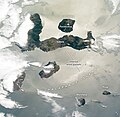Файл:Galapagos Islands astronaut photo from ISS 2020.jpg
Перейти до навігації
Перейти до пошуку

Розмір при попередньому перегляді: 617 × 600 пікселів. Інші роздільності: 247 × 240 пікселів | 494 × 480 пікселів | 720 × 700 пікселів.
Повна роздільність (720 × 700 пікселів, розмір файлу: 432 КБ, MIME-тип: image/jpeg)
Історія файлу
Клацніть на дату/час, щоб переглянути, як тоді виглядав файл.
| Дата/час | Мініатюра | Розмір об'єкта | Користувач | Коментар | |
|---|---|---|---|---|---|
| поточний | 16:44, 8 вересня 2021 |  | 720 × 700 (432 КБ) | Tillman | {{Information |Description=Galapogos Islands: Sunglint helps tease out features that are not often visible. This photograph, taken by an astronaut from the International Space Station, offers a peek at several of the Galápagos Islands, visible between cloud cover and accented by sunglint on the ocean surface. The sunglint helps reveal features that are usually hard to spot, such as the lake occupying the summit caldera of La Cumbre, the shield volcano that makes up Fernandina Island. The you... |
Використання файлу
Така сторінка використовує цей файл:
Глобальне використання файлу
Цей файл використовують такі інші вікі:
- Використання в en.wikipedia.org
- Використання в mr.wikipedia.org

